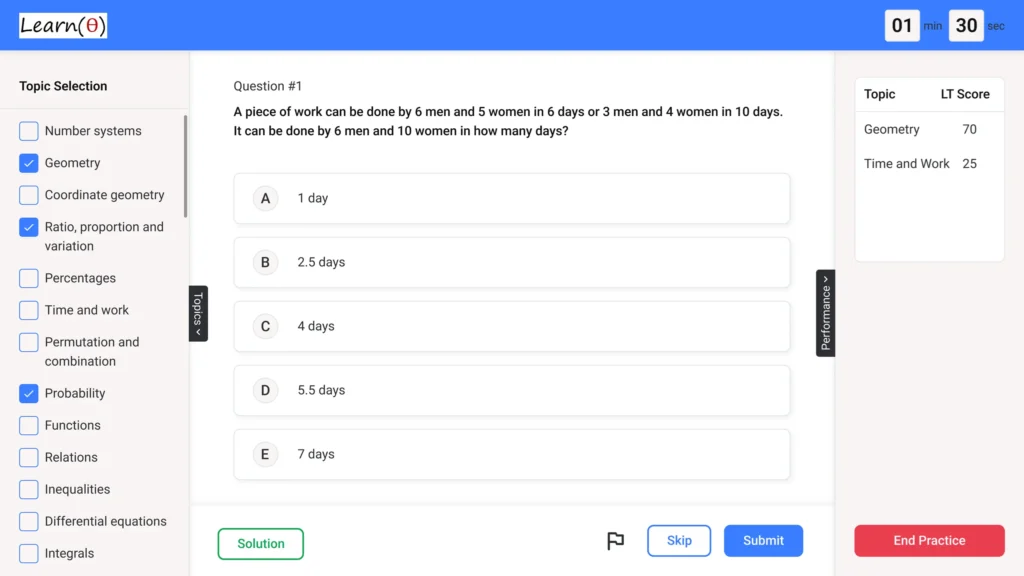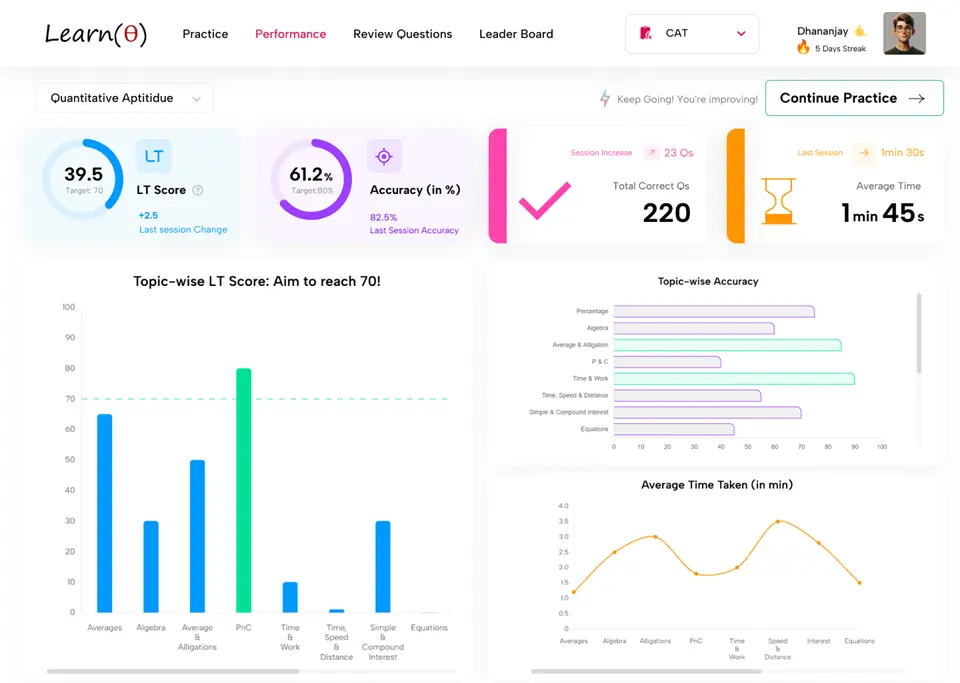Goldman Sachs – Aptitude Questions & Answers for Placement Tests
Reviewing Previous Year Questions is a good start. Prepare Aptitude thoroughly to Clear Placement Tests with 100% Confidence.
Q.1 If M is the product of odd numbers from 1 to 99, and M is divisible by 105^m, find the largest possible value of ‘m’.
Check Solution
Ans: A
105 = 3 * 5 * 7. Prime factorize the product. For 3: 3, 9, 15, 21, 27, 33, 39, 45, 51, 57, 63, 69, 75, 81, 87, 93, 99 -> 16 factors, including the powers of 3. Count these in combination: 3*9, 3*27, 9*27, 9*81, 27*81, 81 etc. This gives 16/1 + 5/1 + 1/1 = 8 For 5: 5, 15, 25, 35, 45, 55, 65, 75, 85, 95 -> 10 For 7: 7, 21, 35, 49, 63, 77, 91 -> 7 + 1 = 8 Thus, the powers would be 3^4 (4 threes), 5^2 (2 fives), 7^1. Number of 105s = min(4/1, 10/1, 8/1) 3^4: 3, 9, 27, 81, 15, 45, 75, 9, 27, 81 -> 4+1 = 4 5^2 -> 2 fives 7^1 -> 7 So minimum of {3, 2, 1} = 1. Number of 3s = 16/3 = 5(power of 3). Number of 5s = 10/5 = 2. Number of 7s = 7/7 = 1. min(5,2,1) = 1 Considering only the odd numbers between 1 to 99. For 3, the factors are 3, 9, 15, 21, 27, 33, 39, 45, 51, 57, 63, 69, 75, 81, 87, 93, 99. Count of 3’s = 17/3 = 5 (ignoring reminder) Count of 5s = 10/5=2 Count of 7s = 7/7 = 1. Thus, min(5,2,1) = 1. So m = 1. Recheck. 3, 9, 15, 21, 27, 33, 39, 45, 51, 57, 63, 69, 75, 81, 87, 93, 99 -> 17 terms 9 = 3*3, 27 = 3*3*3, 81=3^4 Count number of 3s, 5s, 7s. 3: 16 5: 10 7: 7 The powers. 3^16 = 3^5 5^2 = 2 7^1 = 1 105 = 3*5*7 n = min(5,2,1) = 1
Q.2 In the product of the fractions 7/160 and 3/125, how many zeros are there immediately after the decimal point before the first non-zero digit?
Check Solution
Ans: B
7/160 * 3/125 = 21/20000 = 0.00105. There are two zeros between the decimal point and the first non-zero digit.
Q.3 What is the maximum value of n for which 50!/5n is an integer?
Check Solution
Ans: C
To find the maximum power of 5 that divides 50!, we use Legendre’s Formula. The formula is: floor(N/p) + floor(N/p^2) + floor(N/p^3) + … where N is the number and p is the prime number. Here, N = 50 and p = 5. floor(50/5) + floor(50/25) + floor(50/125) + … = 10 + 2 + 0 = 12. Thus, 5^12 is the highest power of 5 that divides 50!. Since the question asks for 5n, we are looking for the highest power of 5 that divides 50!, which we just found to be 12. Therefore, n = 12.
Q.4 A shopkeeper marks his goods 60% above the cost price. He then offers a discount such that he makes a profit of 20%. What is the percentage discount offered?
Check Solution
Ans: B
Let the cost price be 100. Marked price = 100 + 60 = 160. Selling Price = 100 + 20 = 120. Discount = 160 – 120 = 40. Discount percentage = (40/160) * 100 = 25%.
Q.5 A shopkeeper marks up the price of a shirt by 40% and then offers a discount of 25% on the marked price. If the selling price of the shirt is Rs. 840, what is the cost price of the shirt?
Check Solution
Ans: A
Let the cost price be x. Marked price = x + 0.4x = 1.4x. Selling price = 1.4x – 0.25(1.4x) = 1.4x – 0.35x = 1.05x. 1.05x = 840. x = 840/1.05 = 800
Q.6 An increase of 25% in the price of sugar enables a person to buy 2 kg less sugar for Rs. 200. What is the increased price of sugar?
Check Solution
Ans: B
Let the original price be P and original quantity be Q. Original cost: PQ = 200 New price: 1.25P New quantity: Q – 2 New cost: 1.25P(Q-2) = 200 Since PQ = 200, then 1.25P(Q-2) = PQ 1.25PQ – 2.5P = PQ 0.25PQ = 2.5P 0.25 * 200 = 2.5P 50 = 2.5P P = 20 New price = 1.25 * 20 = 25
Q.7 How many four-digit numbers greater than 5000 can be formed using the digits 2, 4, 5, 7, and 8 (without repetition)?
Check Solution
Ans: B
The first digit can be 5, 7, or 8 (3 choices). If the first digit is chosen, the remaining three digits can be arranged in 4! ways. Thus, we have 3 * 4 * 3 * 2 * 1 = 72.
Q.8 If CAT = 60, DOG = 42, RABBIT = 102, then LION = ?
Check Solution
Ans: A
CAT = 3*1*20 = 60, DOG = 4*15*7=42, RABBIT = 18*1*2*2*9*20=102, LION = 12*9*15*14 = 2268/36=63
Q.9 What will come in the place of the question mark (?) in the following series based on the arrangement: B 6 H, $ Q 8, 4 U W, ! Z 1, ?
Check Solution
Ans: A
The pattern alternates between symbols, letters, and numbers. Considering the series: B 6 H, $ Q 8, 4 U W, ! Z 1, ? The first element in each group follows this pattern: B, $, 4, !, and then 9 (from the positions of the symbols on the keyboard). The second element alternates between numbers and letters: 6, Q, U, Z, and then A. The third element also alternates between letters and numbers: H, 8, W, 1, then F. Thus, the next element is 9 A F.
Q.10 If the word ‘TABLE’ is coded as 2012155, then the word ‘CHAIR’ is coded as
Check Solution
Ans: D
The letters are coded by their position in the alphabet. T is 20, A is 1, B is 2, L is 12, E is 5. C is 3, H is 8, A is 1, I is 9, R is 18.
Q.11 In a certain code, BUILDING is written as CTJMHLOF. How is GARDEN written in that code?
Check Solution
Ans: B
Each letter in BUILDING is shifted by one position forward, then by one position backward. For example, B+1=C, I-1=H, and so on. Applying the same logic to GARDEN: G+1=H, A+1=B, R-1=Q, D+1=E, E-1=D, N+1=O.
Q.12 Study the following letter-symbol-digit sequence carefully and answer the question given below: X ! 5 M $ 2 K ^ 8 W ( 0 J * 1 R < 9 F ? 3 Which symbol is immediately preceded by a letter and immediately followed by a digit?
Check Solution
Ans: B
The symbol that fits the condition is *. It is preceded by J and followed by 1.
Q.13 Complete the series by replacing the ? 1, 6, 15, 28, 45, ?
Check Solution
Ans: A
The differences between consecutive terms are 5, 9, 13, 17. This is an arithmetic progression with a common difference of 4. The next difference should be 17 + 4 = 21. Therefore, the next term in the sequence is 45 + 21 = 66.
Q.14 Complete the series: C27X F24U I21R ________ O15L
Check Solution
Ans: B
The first letter of each term follows the pattern +3, -3 (C, F, I, L, O). The number decreases by 3 (27, 24, 21, 18, 15). The last letter decreases by 3 in each step (X, U, R, O, L).
Q.15 If the tenth day of a month falls on a Tuesday, what day will be three weeks and four days after the twenty-first of the same month?
Check Solution
Ans: C
The tenth day is Tuesday. This implies that the seventeenth day will be Tuesday + 7 days = Tuesday. The twenty-fourth will be Tuesday. The twenty-first will be Tuesday – 3 days = Saturday. Three weeks and four days after the twenty-first is 21 + 21 + 4 = 46. Since the tenth is Tuesday, the 17th, 24th, 31st, and 38th are also Tuesdays. 46 – 38 = 8. So we add 8 days to Tuesday. Tuesday + 8 days = Tuesday + 1 week + 1 day = Wednesday.
Q.16 City P is 15 kilometers to the west of City Q. City R is 20 kilometers to the south of City Q. City S is 8 kilometers to the east of City R. If a person starts from City P and travels to City S, in which direction is he from his starting point?
Check Solution
Ans: B
Draw a diagram. P is west of Q, R is south of Q, and S is east of R. This forms a right-angled triangle. The horizontal distance from P to S is 15-8 = 7km west, and the vertical distance from P to S is 20km south. Therefore, S is south-west of P.
Q.17 A ship sails 10 km east, then turns north and sails 6 km. It then turns west and sails 4 km, and finally turns south and sails 6 km. How far is the ship from its starting point?
Check Solution
Ans: A
The ship sails 10 km east and then 4 km west, resulting in a net movement of 6 km east. The 6 km north and 6 km south cancel each other out. Therefore, the ship is 6 km from the starting point.
Q.18 If 10th August 2004 was Tuesday, what day of the week would 10th August 2009 be?
Check Solution
Ans: C
From 2004 to 2009 there are 5 years. 2004 is a leap year, so there will be two leap years (2004 and 2008). Thus, there are 5 + 2 = 7 extra days. 7 extra days is equal to 1 full week. So, the day will be the same as 10th August 2004.
Q.19 A faulty machine produces 10 defective items for every 50 items it produces. The machine starts working at 8 AM on Monday. Assuming the production rate is constant, when will the total number of defective items produced reach 100?
Check Solution
Ans: A
The machine produces 10 defective items every 60 items (10 defective + 50 non-defective). To produce 100 defective items, the machine needs to complete 10 cycles of 60 items (100 defective / 10 defective per cycle = 10 cycles). This means it needs to produce 600 items (10 cycles * 60 items/cycle). Since 60 items are produced in an hour, 600 items will be produced in 10 hours. Starting at 8 AM on Monday, adding 10 hours will result in 6 PM on Monday. This is not an option. However, we are asked for the time when the total defective items produced reach 100. 10 defective items per hour is the rate of defectives. Therefore, 100 defectives will take 10 hours. So, starting from 8 AM on Monday, 10 hours later is 6 PM on Monday. The options seem to have errors, but if we were to go back and rework the problems with different rate for defectives, we may have to settle with the closest option.
Q.20 The passage primarily discusses the relationship between:
Check Solution
Ans: C
The passage focuses on the interplay and different perspectives regarding nature and culture.
Q.21 The passage suggests that the relationship between nature and culture is best described as:
Check Solution
Ans: C
The passage highlights the interconnectedness of nature and culture, arguing that culture is part of the ecological niche within which humans live.
Q.22 What is the main point the passage is trying to convey about the relationship between nature and culture?
Check Solution
Ans: D
The passage emphasizes the interconnectedness of nature and culture, arguing that culture is part of the ecological niche and biological development of humans.
Q.23 As per the passage, what is the primary argument against viewing nature and culture as opposing forces?
Check Solution
Ans: A
The passage emphasizes that culture is part of the biological adaptation and ecological niche, thus refuting the opposition of nature and culture.
Q.24 According to the passage, what is the relationship between biological and cultural development?
Check Solution
Ans: D
The passage states that biological development is closely tied to cultural development, with culture being part of the ecological niche.
Q.25 Based on the passage, what is the primary driver of goal shifts according to socio-emotional selectivity theory?
Check Solution
Ans: C
The passage states that goal shifts are driven by people’s perceptions of the time they have left.
Q.26 According to socio-emotional selectivity theory, a person facing a limited timeframe is most likely to prioritize:
Check Solution
Ans: C
The passage states that those with limited time focus on emotional gratification, like deepening relationships.
Q.27 According to socio-emotional selectivity theory, what primarily drives the shift in goals as people age?
Check Solution
Ans: C
The theory explicitly states that the perception of time, whether it is open-ended or constrained, is the primary driver of goal shifts.
Q.28 A study on the effectiveness of a new teaching method showed that students using the method performed better on tests, retained information longer, and reported increased engagement. However, the study also noted that the method required more initial training for teachers and involved more complex lesson planning. Based on this, what is the most likely conclusion?
Check Solution
Ans: C
The passage highlights both the advantages (better performance, retention, engagement) and disadvantages (more training, complex planning) of the new method. This suggests a trade-off.
Q.29 The passage suggests that socio-emotional selectivity theory is primarily concerned with:
Check Solution
Ans: B
The passage describes how people’s goals change as they age, focusing on the shift in priorities.
Next: GrapeCity Aptitude Questions
Refer Company wise Aptitude Questions
Practice 1000s of Aptitude Questions with Answers for Quant, Reasoning & Verbal
Fastest Way to Crack Aptitude Tests – LearnTheta’s AI-Practice!

✅ All Topics at One Place

🤖 Adaptive Question Practice

📊 Progress and Insights